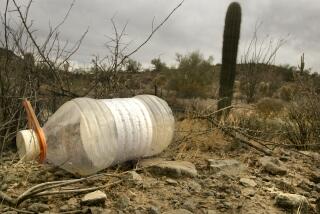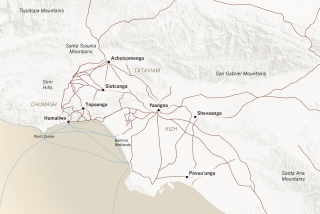Arabian Adventure : Modern Explorers Sift Desert Sands in Search of Lost City of Ubar
- Share via
T. E. Lawrence called it “the Atlantis of the sands,” and it was so fabled a city that more than 50 years ago British explorer Bertram Thomas scoured the Rub al Khali (Empty Quarter) desert in search of it, until he ran low on food and water and was forced to abandon his search.
But now, an eclectic team of explorers led by Nicholas Clapp, a soft-spoken Los Angeles filmmaker, believes it is on the road to finding the lost city of Ubar, deep in the desert of Oman.
Their quest for the ancient metropolis, which was built around the trade in frankincense, has been attended by plenty of Arabian romance: fierce sandstorms, encounters with wild animals and now the complications of modern civilization--the crisis in the nearby Persian Gulf.
Clapp’s hunt for Ubar began casually eight years ago with a bookseller’s recommendation: “I went in looking for a book, and she handed me ‘Arabia Felix’ and said, ‘You read this,’ ” he recalled.
In the book, Thomas, a British Army officer, onetime aide to the Sultan of Oman, protege of Lawrence and one of only two Westerners to traverse the dunes of the Empty Quarter, described his unsuccessful mission to discover the ruins of the “great city.”
Clapp had been to Oman in 1980 and was looking for a project to take him back. After reading Thomas’ 1932 account of the road to Ubar, Clapp had found his project: the search for Ubar.
While other explorers had sifted the sands of time in search of the smallest clues, this expedition would be a high-tech archeological effort guided by computer-enhanced images from space, run by a team of amateur and professional explorers and financed by the Oman government.
When Thomas gave up his search years ago, he carefully noted the coordinates of the road he believed led to the lost city before leaving the desert. “Some few days to the north . . .,” said Thomas’ guides as they labored under the desert sun to help the Western explorer map a road that someone might someday follow.
Clapp, an Emmy Award-winning documentary filmmaker for Armand Hammer Productions, decided he would be that someone. Clapp began to read everything he could find about Ubar. He found tales of the lost city’s splendor in everything from the Koran to “A Thousand and One Nights.”
Although separating fact from fantasy proved difficult in the diverse accounts, Clapp began to get a picture of the fabulously wealthy city that existed about the time the lucrative frankincense trade started. That city had thrived for at least 2,000 years before the birth of Christ.
Its prized incense, more valuable than gold during Ubar’s heyday, came from trees found only in the hills of what is now the Dhofar region of Oman. An aromatic resin derived from tree sap, frankincense brought great wealth to those who controlled its harvest and distribution, including Ubar’s residents. It was used in a wide range of rituals and ceremonies, including cremations and royal processions.
But the Koran notes that great wealth did not lead to great happiness for the people of Ubar. Because they lived sinful lives and refused to repent, the Islamic holy work says, Allah ultimately destroyed their “many columned city . . . whose like has never been built in the whole land.”
“The whole key to the mystery and romance of ancient Arabia is rooted in the frankincense trade,” Clapp said, noting that scholars have studied the trade “farther on up the route it was traded. But virtually nothing is known of the trade at its source.”
Clapp and colleagues have now begun to change that. This summer, after years of planning, Clapp, along with Los Angeles lawyer George Hedges, Jet Propulsion Laboratory geologist Ronald Blom, archeologist Juris Zarins and famed British explorer Sir Ranulph Fiennes, finally stood on the sands traversed by Thomas.
They began unearthing what they hope will be evidence of the so-called Ad civilization that spawned the lost city of Ubar, if not the city itself.
Their short expedition in July, staged in preparation for a major exploratory trip this winter, did not locate the city with certainty.
But it did uncover artifacts--about 900 pottery shards and flint pieces--that suggest they are on the right tract. The frankincense trade route, at the least, has been discovered.
Certain they have uncovered long-buried clues to the ancient people who built the trade, the men remain hopeful of finding Ubar.
One obstacle may be the troubles in the Persian Gulf. Oman borders Saudi Arabia, and the next expedition, Clapp said, will “of course await the settling of hostilities.”
Clapp knew from the beginning that searching for the remnants of one small city in the vast and desolate Rub al Khali dunes would be a formidable task. And he had no intention of venturing into the desert until he had done as much preparation as possible. He began looking for ways that technology could help him.
Armed with only his historical references and with Thomas’ notes about the lost road, Clapp approached Pasadena’s Jet Propulsion Laboratory.
“This guy called up and said, ‘I’m trying to find a lost city,’ ” recalled Ronald Blom, a JPL geologist. “My first thought was that this was a crank call.”
But as Blom listened to Clapp, he found himself engrossed in the project; before long, he and his boss, Charles Elachi, were part of the search.
Elachi headed JPL’s Shuttle Imaging Radar program, part of an effort to generate and use images from a sophisticated radar system carried on the space shuttles. He and Blom believed the radar might help locate traces of civilization in the Rub al Khali because it can produce images of objects buried in the sands.
It did. In 1984, during the Challenger’s next-to-last flight, the Shuttle Imaging Radar system gathered data as it passed over Oman. From that data, high-tech images were generated and later enhanced with images from French and American satellites.
At almost exactly the spot noted by Thomas, in a stretch of Arabian desert so deserted that it is known as the “Empty Quarter,” the men found evidence of a 100-yard-wide road connected to dozens of other ancient roads in the region.
Images in hand, Clapp turned his attention to assembling an expedition team, a job that proved to be less than difficult. “Everyone I spoke to was very enthusiastic about this project,” Clapp said.
JPL’s Blom, already hooked into the Ubar quest, signed on for the expedition. Clapp also approached his friend, lawyer Hedges, who, as a student of classics and archeology, promised to bring another view to the project.
“Nick knows that I am not a quitter. When I start something I make it happen,” Hedges said. “And I had a real romantic feeling about this project right from the beginning. It really appealed to my spirit of adventure. It was immediate, full-blooded enthusiasm on my part.”
Realizing that they needed more technical guidance, the team approached Juris Zarins, an archeologist at Southwest Missouri State University, who had spent several years doing fieldwork in the Arabian desert.
To complete the team, they invited Sir Ranulph Fiennes, a dashing British adventurer and explorer who had fought with the Sultan of Oman’s forces during a rebellion in the late 1960s.
But even with the team in place, the expedition faced imposing obstacles, most of them financial. Ultimately, the team found support from various sources, including $15,000 from the Oman International Bank, free transportation from Gulf Air and full tactical support and transportation within Oman from its government, an absolute monarchy that rules the Kansas-sized country of 1.3 million people.
In Oman, the team received red-carpet treatment. Within days of arrival, the expedition had a helicopter, a pilot and ground vehicles from the Omani military, and a cadre of armed escorts from the Royal Omani Police.
“We told the Omanis, ‘There’s a big hole in your history,’ ” Clapp said. “ ‘We know your ancestors controlled the most valuable commodity in the ancient world. But we don’t know anything about the people who ran the trade prior to 100 BC.’ The Omanis were very interested in learning with us.”
Before they left the United States, Clapp and Zarins had compiled a list of 35 sites to investigate. Almost immediately they began to uncover what archeologist Zarins believes are artifacts from the incense civilization.
Some of what they found was from well-studied periods, including fragments of classical pottery. But Zarins was more excited about small bits of an indigenous, reddish-brown pottery discovered at several sites. “Some of the pottery was really different and represented an unexplored aspect of the region,” Zarins said.
Beyond the thrill of discovery, the expedition brought the hurdles that have historically troubled the most intrepid explorers. Raging sandstorms cut short the group’s work in the Empty Quarter, where they had most expected to find the city of Ubar. Giant “heat-seeking” ticks chased them around a cave that they had entered to escape the heat.
Tired of the ticks and concerned about the return of a leopard that also seemed to inhabit the cave, the men resumed their desert search, only to come upon a deadly Arabian viper. Not far from that, they came upon a scorpion.
But the trip also had its serendipitous moments. One day while driving between two sites, Zarins and Hedges stopped for a cold drink. Near the car, Zarins noticed something strange. “Archeologists are trained to look for things in the landscape that are out of place. I noticed some nearby stones that rose too high, so we went to investigate,” Zarins said.
There the men found more of the indigenous pottery as well as evidence of structures that they believe tie the site to the incense trade.
“We went looking for clues to a lost city,” Hedges said, “and we came back with what may well prove to be evidence of an entire civilization.”
More to Read
Sign up for The Wild
We’ll help you find the best places to hike, bike and run, as well as the perfect silent spots for meditation and yoga.
You may occasionally receive promotional content from the Los Angeles Times.







